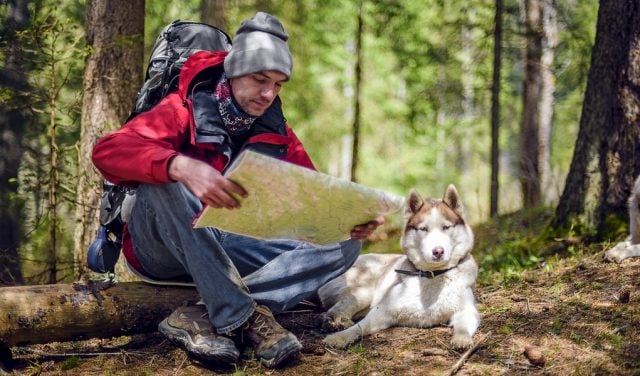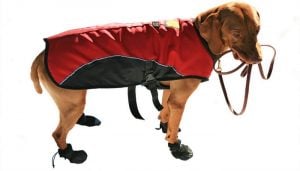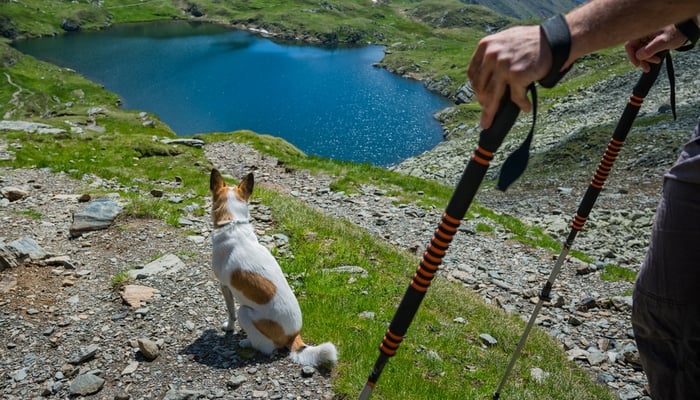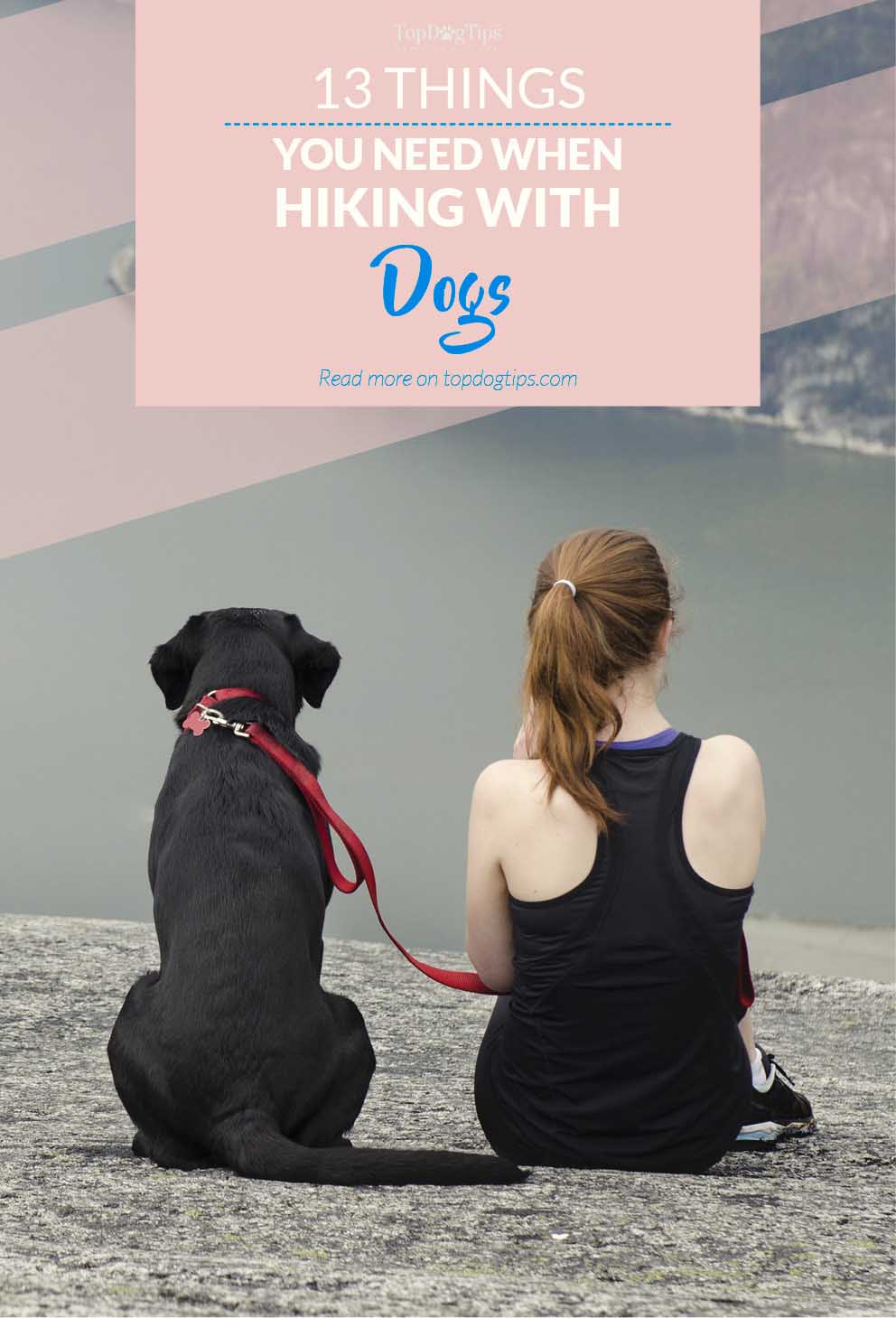
Table of Contents
Preparation is key when it comes to hiking with your dog.
Hiking is a great opportunity to give your dog the physical exercise he needs, expose your dog to new stimuli, and spend time bonding with him.
Always carrying the necessary dog hiking gear is important to facilitate a safe hiking trip.
The phrase “safe hiking trip” refers to an adventure where you are prepared for EVERY eventuality.
When taking your dog on a hiking trip with you, being prepared in this way means carrying the gear necessary to keep both you and your dog safe.
The first things an aspiring dog hiker needs to keep in mind are the laws and safety precautions set out by the USDA and other agencies trying to provide a safe and secure outdoor environment for everyone.
Second, you'll also need to prepare and have the right dog hiking gear before you leave.
You may think about some of the more common necessities, like dog food and water.
But did you ever think about bringing a canine first kit, dog boots for paw protection, or an electrolyte supplement for emergencies?
There are many dog hiking gear supplies that owners don't think of when planning their outdoor adventure and get pets into trouble.
Let's talk of these necessities so that you or your dog don't end up dead like this pooch.
READ MORE: A Basic Guide to Hiking with Dogs
Dog Hiking Gear Guide
13 Items You'll Need for Your Hike
There are plenty of items that you can take or leave when it comes to hiking with your dog.
That GPS unit? That’s one of those items.
However, you should always remember to take along several basic pieces of dog hiking gear.
1 Waste Bags
Waste bags are a necessary part of going anywhere with your dog.
When hiking, take biodegradable doggy waste bags and ALWAYS pick up after your dog.
Cleaning up after dogs is important not only to keep the trails clean for other hikers but it's essential for the environment as well, since dog poo – believe it or not – is harmful, says science.
2 A First Aid Kit
A first aid kit that is made specifically for pets is a definite necessity when hiking with dogs.
You can purchase a kit at a pet retail store or online if you choose. It's also very simple to make your own canine first aid kit and much cheaper than buying it pre-made.
Whether you choose to purchase one or make your own, you need to be sure to include:
- gauze pads

- adhesive tape
- hydrogen peroxide
- sterile saline solution
- non-prescription antibiotic ointment
- petroleum jelly
- foil emergency blanket
- cotton balls or swabs
- disposable gloves
- blunt ended scissors
- tweezers
- a copy of your dog's medical records
- temporary identification tag
- leash
- muzzle
- cling bandage that won’t stick to fur
- rectal thermometer
- dog nail clippers
…and be sure to check the supplies before setting out for your hiking adventure.
Replace anything that has been used, and check to make sure no products have expired.
3 Water for Your Dog
Water is an obvious need for both you and your dog when hiking, but Fido also requires a water bowl or other drinking option.
Some hikers rely on collapsible dog bowls for water, but a “dog travel mug” option is generally one of the most efficient.
These devices fit on top of your own bottle of water, but they collect water so that your pup can drink without having to use the bottle itself.
These dog hiking gear products keep your water fresh for you to drink and make drinking easier for your pet.
4 An Electrolyte Supplement
An electrolyte supplement is something that should be carried by any hiker who is hiking with their dog.
An electrolyte powder or drink will help to ensure that a dog does not become dehydrated or experience an electrolyte imbalance on long hikes.
Just like us, dogs need to have their electrolytes replenished when exerting themselves.
Veterinary-specific electrolytes are preferable, but in a pinch, Pedialyte or Gatorade will do.
Just remember to carry your own water bottle and a separate water bottle for your dog.
5 Dog Boots
First of all, all other reasons to use dog shoes aside, if you do it right, then your pet will simply look cool.
Take a look at this guy from Pugventurephoto's Instagram:
It may seem odd to put boots on a dog, but hiking terrain can be exceptionally rough on a dog’s paws.
Rocks can wear and tear at a dog’s paw pads; wood trails can have sharp thorns. Even concrete can burn sensitive paw pads!
Dog boots should be suited to the terrain where you will be hiking.
A firm sole with the ability to grip and a well-fitted boot is always a must, but hiking in hot weather requires mesh, breathable boots.
Hiking in cold terrain, though, requires insulated boots.
6 Dog Cooling Vest
 Hiking with your dog in hot weather is never advised, but even hiking in warmer weather can take a toll on a canine.
Hiking with your dog in hot weather is never advised, but even hiking in warmer weather can take a toll on a canine.
When hiking in warmer weather (especially for longer distances) look into purchasing a cooling vest for your dog.
There are two types of cooling vests to choose from:
- Evaporative Vests – These cooling vests fit over a dog’s back and sides and are soaked in water before being fitted to his body. Over time, the water evaporates and cools the dog. These vests are great in that they work without any inserts, but they also only tend to last for an hour at a time before needing to be wet down again.
- Chill Pack Vests – These cooling vests fit over a dog’s back and sides and are packed with cold packs to provide cooling. These vests work in the same way that applying a cold pack works. They are great in that they provide cooling for a longer period of time, but they cannot be “re-chilled” once they warm up.
TRY THESE: Top 15 Best Cooling Vests for Dogs To Prevent Heatstrokes
When choosing a cooling vest for your dog to use on a hike, it’s important to select one that suits the amount of time and distance that you plan to cover while hiking.
For example, if you are hiking for a long period but will be near water where an evaporative vest can be rewetted, then this is the optimal choice.
If, however, you are going for a shorter hike on a warmer day, it is more beneficial to take a chill pack vest.
7 A Doggy Coat
When the weather turns cold, you don’t have to stop hiking, but you do have to consider your dog’s body temperature.
In addition to boots, a coat is a necessary piece of dog hiking gear for any pup, but especially for:
- dogs with thin (or no) fur
- dogs that have a slender build
- dogs with low body fat content
- younger dogs
- older dogs
- smaller dogs
- dogs with any medical condition impairing their ability to keep warm
A coat should be warm enough to maintain body heat, and it should also be windproof to protect against wind chill.
Just because pets have more hair and fur than we do, that doesn't mean they're resistant to cold. If you're cold, then your dog may be too.
This guy understands this (photo from @Kellll_bell89):
8 A Dog Harness
A dog harness is not a must-have for everyone, but having a harness for your dog can help to lift, carry, or otherwise maneuver your dog if an emergency situation arises during your hike.
It's one of the most important items to have for any dog owner, not just hikers.
The right harness choice for your dog will depend on the dog’s breed and size, but an ideal harness will have a handle on the back to provide an easy handling point.
We've listed some of the best dog harnesses for walking, hiking, and other reasons so you have an easier time choosing one.
Remember that some owners may have a dog who's not supportive of your idea to put a harness on him, thereby making the whole process much more difficult.
If that's you and your pooch, then watch this video on how to put on a dog harness quickly and easily.
9 ID Tags for Dogs
 A hiker with even the most well-behaved dog can run into a situation where the pooch breaks free or where they must set their dog free (for example, if a hiker begins to slip or fall down a steep trail).
A hiker with even the most well-behaved dog can run into a situation where the pooch breaks free or where they must set their dog free (for example, if a hiker begins to slip or fall down a steep trail).
Dog ID tags are very important in helping other hikers or locals to identify your dog if such an incident takes place.
ID tags should include your dog’s name, your own name, your address, and your phone number.
All of this information should be up to date, so make sure to double-check before going on a hiking trip with your dog.
10 A Microchip
ID tags are ideal because they offer instant access to your dog’s (and your) information, but they can get lost or caught on branches.
A dog microchip offers a backup option should your dog become lost, making finding them much easier.
Losing a dog is never fun, even more so when you lose your pooch while hiking in the mountains, making it that much harder to find him.
Using ID tags and microchips will be a life savior as long as you remember to maintain them.
For example, as with ID tags, it is crucial to keep your dog's microchip information up to date at all times.
Alternatively, or in addition to both dog ID tags and microchips, you can also invest in something called a GPS collar for dogs.
These collars will help you locate your dog quickly, and you'll know exactly where he is at all times.
You can get a GPS tracking system or cheaper options for your phone. Read more on the best dog GPS collars here.
RELATED: 13 Dog GPS Trackers’ Service Costs Compared
11A Photo of Your Dog
Photo identification of your dog is important to keep on hand in case Fido gets loose from you during a hike and gets lost for good.
These things happen, and many cases have been reported and documented of dogs getting lost on hiking trips.
Having your dog's photograph to share with other hikers can help to locate him sooner rather than later.
That is if you do not use any of the above-mentioned tools, such as GPS trackers, to locate him (all of which would be much easier, of course).
12 Vaccines for Hiking Dogs
 It may not seem like something you should worry about when it comes to hiking, but some vaccinations are designed specifically for dogs that spend a lot of time outdoors. One such vaccination is leptospirosis, and most hikers with dogs do this for their canines.
It may not seem like something you should worry about when it comes to hiking, but some vaccinations are designed specifically for dogs that spend a lot of time outdoors. One such vaccination is leptospirosis, and most hikers with dogs do this for their canines.
Talk to your vet about any vaccinations your dog might need before you go hiking, and make sure that your dog is always up to date on these vaccines.
However, keep in mind that not all vaccines are healthy, and there is always a danger of over-vaccination.
13 A Seat Cover for your Vehicle
Lastly, if you are traveling without your dog in a crate, you will want to invest in a seat cover for your vehicle.
A seat cover should be waterproof and have slots that allow for the use of a canine seatbelt harness. There are tons of different designs of this, however.
For example, hammock-style dog seat covers are best as they contain any dirt and debris within the seat cover.
We showed how they work in covering your car and containing your muddy dog in our best dog car seat cover video here.
Take a look at the designs and see available options that fit your vehicle and your pooch best.
Other Hiking Gear to Consider
In addition to the canine hiking gear mentioned above, there are a few other pieces of gear you might want to consider.
- A brush guard to protect against thorny terrain
- A beacon safety light for a night or dusk hiking
- A canine sleeping bag for overnight stays
Finally, talk to others who love hiking with dogs and already know all the best dog hiking gear that is necessary for these adventures.
People who go out camping with dogs and hunters with gun dogs may also give you some great tips about being outdoors with your canine for extended periods of time, and how to keep yourself and your dog safe.
READ NEXT: 35 Unique Summer Adventures to Have with Your Dog















